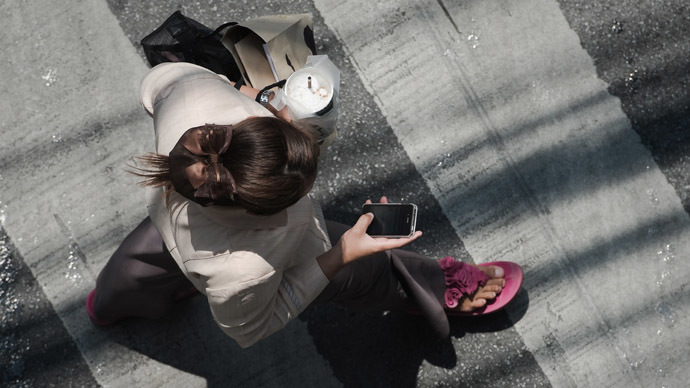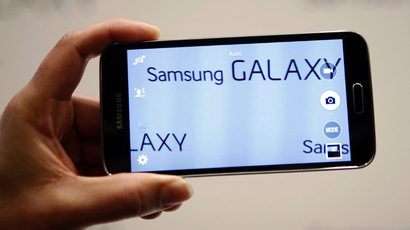Smartphone separation: Chinese city creates special sidewalk lane for cell phone users

The Chinese city of Chongqing has come up with a novel way to counter problems of “sidewalk rage” – by separating mobile users from other pedestrians. They have created a special lane to let them text and browse in peace.
The sidewalk in question is located in a popular tourist spot in the southwest Chinese city. It seeks to give those who want to stroll at a leisurely pace and stare at their smartphones the opportunity to do so, without incurring the wrath of those wishing to get from A to B at a much faster pace.
There are white lines painted on the pavement, which clearly distinguish the lanes for cellphone users and those wanting to walk at a quicker pace. A prominent sign says, “Cell phone users walk in this lane at your own risk.” China is the world’s largest smartphone network, with around 500 million smartphone users, according to China Daily.
Walkie-Talkie. China's first pedestrian #Talkway for users of mobile phones is in Chongqing: http://t.co/ofzWB7TbwJpic.twitter.com/IKDpwJkjiQ
— Steve 史進 (@ChineseCurrents) September 13, 2014
“There are lots of elderly people and children in our street, and walking with your cellphone may cause unnecessary collisions here,” said Nong Cheng, a marketing official with Meixin Group, which manages the area in the city’s entertainment zone, AP reported.
However, the 50-meter section of the sidewalk has now become something of a tourist attraction in Chongqing, with tourists stopping to take photos, on their smartphones of course, of the new idea.
The idea is nothing new. In July a section of a sidewalk in Washington DC was painted with separate lanes for those wanting to look at their cell phones, while another lane was for quicker walkers. It was part of a behavior experiment by National Geographic Television.
According to Yahoo.com, who sent a reporter to sit with the researchers from National Geographic for a few hours, only a small number of pedestrians actually moved into the correct lane once they spotted the markings.
However, once those with cellphones noticed the lane that had been created especially for them, just like in China, they would stop to take a picture.
In Chongqing, China, there are cell phone walking lanes. #wowpic.twitter.com/PLNKWAJq9v
— Dan Pontefract (@dpontefract) September 14, 2014
Although the creation of the special lanes for cellphone users may have been tongue in cheek aimed at having a bit of fun, the problem of “sidewalk rage” is a growing problem.
"We're trying to understand what makes people angry, what that experience is like," says Jerry Deffenbacher, a professor at Colorado State University who studies anger and road rage. "For those for whom anger is a personal problem, we're trying to develop and evaluate ways of helping them,” the Wall Street Journal reported.
It is common for those in a hurry to get from A to B in their native city to get annoyed by slow-paced shoppers or tourists clogging the sidewalks, but there are those who take their levels of rage to a different level.
"A lot of us have 'shoulds' in our head. Ragers tend to think people should do things their way, and get angry because the slow walkers are breaking the rules of civility. It's unclear exactly why some people harbor such beliefs,” Dr. Deffenbacher continued. “Such ways of thinking are generally learned from family, friends or the media,” he added.
“Ragers' thoughts tend to be overly negative, over-generalized and blown out of proportion, leaving them fuming about how they can't stand the situation, how late they are going to be, and how this always comes up. In contrast, someone blissfully free of sidewalk rage may still be frustrated, but thinks more accepting thoughts such as, ‘This is the way life is sometimes’ or, ‘I wish that slow person wasn't in front of me,’” said Deffenbacher, a professor from the University of Colorado.
It is yet to be seen whether the phenomenon in Chongqing will catch on, however, but proponents hope it will lead to a few less accidents as those wanting to bide their time and look at their latest news on Twitter will be able to do so free in the knowledge they will not be bumped into by someone in a hurry – well, for 50 meters at least.














